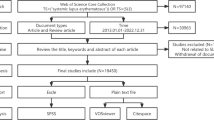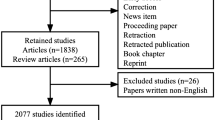Abstract
Background
Antiphospholipid syndrome is an autoimmune disorder characterized by recurrent vascular thrombosis and pregnancy losses in the presence of persistently positive antiphospholipid antibodies. Bibliometric analysis and altmetric analysis are methods of analyzing academic productivity and influence. Currently, the assessment of antiphospholipid syndrome through the above analyses is lacking. This study investigated the quantity and quality of studies in the field of antiphospholipid syndrome and revealed the characteristics of worldwide productivity on this disease by the bibliometric analysis and altmetric analysis.
Methods
The terms “APS,” “antiphospholipid syndrome,” “antiphospholipid-antibody syndrome,” and “Hughes syndrome” were searched on the Web of Science Core Collection from January 1, 2011, to December 31, 2021. Original articles and reviews were selected. We set the filters as “English.”
Results and conclusion
A total of 1818 articles were retrieved from 68 countries, of which 20 met the criteria of major active countries. High-income countries contributed 1341 articles (73.48%). The number of articles annually increased significantly in the 10-year period (P < 0.001). The USA (253, 13.91%) was the most productive country. Adjusted by population, Serbia was top of the list. According to the gross domestic product analysis, Serbia ranked first. The most used keywords such as thrombosis and antiphospholipid antibodies were presented by keywords analyses. A content analysis found antithrombotic and anticoagulant therapy as research hotspots. A significant correlation was detected between average citations and altmetric attention scores (P = 0.002) and Mendeley readers count (P < 0.001). From 2011 to 2021, the number of global articles increased rapidly. Most papers came from high-income countries. The relationship between the bibliometric and altmetric analyses were basically consistent; therefore the two can prove/complement each other.
Key points • We revealed the global productivity characteristics of the papers related to antiphospholipid syndrome by using the methods of bibliometric analysis and altmetric analysis. • We found the most selected articles that describe the treatment of antiphospholipid syndrome, especially antithrombotic and anticoagulant treatments, which may be the current research hotspot. |




Similar content being viewed by others
Data availability
All data generated or analysed during this study are included in this published article.
References
Miyakis S, Lockshin MD, Atsumi T et al (2006) International consensus statement on an update of the classification criteria for definite antiphospholipid syndrome (APS). J Thromb Haemost JTH 4(2):295–306. https://doi.org/10.1111/j.1538-7836.2006.01753.x
Rottem M, Krause I, Fraser A, Stojanovich L, Rovensky J, Shoenfeld Y (2006) Autoimmune hemolytic anaemia in the antiphospholipid syndrome. Lupus 15(7):473–477. https://doi.org/10.1191/0961203306lu2336oa
Faraone I, Labanca F, Ponticelli M, De Tommasi N, Milella L (2020) Recent clinical and preclinical studies of hydroxychloroquine on RNA viruses and chronic diseases: a systematic review. Molecules 25(22). https://doi.org/10.3390/molecules25225318
Bertolaccini ML, Khamashta MA (2008) Diagnosis of antiphospholipid syndrome. Expert Rev Hematol 1(2):183–188. https://doi.org/10.1586/17474086.1.2.183
Cheng S, Wang H, Zhou H (2016) The role of TLR4 on B cell activation and anti-beta(2)GPI antibody production in the antiphospholipid syndrome. J Immunol Res 2016. https://doi.org/10.1155/2016/1719720
Han AR, Lee SK (2018) Immune modulation of i.v. immunoglobulin in women with reproductive failure. Reprod Med Biol 17(2):115–24. https://doi.org/10.1002/rmb2.12078
Hughes GRV (2008) Hughes syndrome (the antiphospholipid syndrome) ten clinical lessons. Autoimmun Rev 7(3):262–266. https://doi.org/10.1016/j.autrev.2007.11.017
Lobo DR, Garcia-Berrocal JR, Ramirez-Camacho R (2014) New prospects in the diagnosis and treatment of immune-mediated inner ear disease. World J Method 4(2):91–98. https://doi.org/10.5662/wjm.v4.i2.91
Tugcu B, Acar N, Coskun CT, Celik S, Yigit FU (2014) Nonarteritic anterior ischemic optic neuropathy as the presenting manifestation of primary antiphospholipid syndrome. Indian J Ophthalmol 62(5):642–644. https://doi.org/10.4103/0301-4738.109535
Grygiel-Gorniak B, Limphaibool N, Puszczewicz M (2018) Clinical implications of systemic lupus erythematosus without and with antiphospholipid syndrome in peri- and postmenopausal age. Prz Menopauzalny Menopause Rev 17(2):86–90. https://doi.org/10.5114/pm.2018.77308
Dabit JY, Valenzuela-Almada MO, Vallejo-Ramos S, Duarte-Garcia A (2021) Epidemiology of antiphospholipid syndrome in the general population. Curr Rheumatol Rep 23(12). https://doi.org/10.1007/s11926-021-01038-2
Duarte G (2020) The epidemiology of antiphospholipid syndrome: a population-based study (vol 71, pg 1545, 2019). Arthritis Rheumatol 72(4):597. https://doi.org/10.1002/art.41241
Pierangeli SS, Chen PP, Gonzalez EB (2006) Antiphospholipid antibodies and the antiphospholipid syndrome: an update on treatment and pathogenic mechanisms. Curr Opin Hematol 13(5):366–375
Zhao X, Chen J, Pan Y, Feng H, Meng B, Meng Y (2019) A bibliometric analysis of the global research in ankylosing spondyloarthritis (2008–2017). Rheumatol Int 39(6):1091–1097. https://doi.org/10.1007/s00296-019-04308-6
Zhao X, Ye R, Zhao L et al (2015) Worldwide research productivity in the field of endocrinology and metabolism - a bibliometric analysis. Endokrynol Pol 66(5):434–441. https://doi.org/10.5603/ep.2015.0054
Kocyigit BF, Akyol A (2021) Bibliometric and altmetric analyses of publication activity in the field of Behcet's disease in 2010–2019. J Korean Med Sci 36(32). https://doi.org/10.3346/jkms.2021.36.e207
Wu H, Li Y, Tong L, Wang Y, Sun Z (2021) Worldwide research tendency and hotspots on hip fracture: a 20-year bibliometric analysis. Arch Osteoporos 16(1). https://doi.org/10.1007/s11657-021-00929-2
Wilson M, Sampson M, Barrowman N, Doja A (2021) Bibliometric analysis of neurology articles published in general medicine journals. Jama Netw Open 4(4). https://doi.org/10.1001/jamanetworkopen.2021.5840
Martinho-Dias D, Sousa-Pinto B, Botelho-Souza J, Soares A, Delgado L, Fonseca JA (2018) Publication trends of allergy, pediatric allergy and immunology, and clinical and translational allergy journals: a MeSH term-based bibliometric analysis. Clin Transl Allergy 8. https://doi.org/10.1186/s13601-018-0191-1
Devos P, Menard J (2019) Bibliometric analysis of research relating to hypertension reported over the period 1997–2016. J Hypertens 37(11):2116–2122. https://doi.org/10.1097/hjh.0000000000002143
Elmore SA (2018) The altmetric attention score: what does it mean and why should i care? Toxicol Pathol 46(3):252–255. https://doi.org/10.1177/0192623318758294
Garcia-Villar C (2021) A critical review on altmetrics: can we measure the social impact factor? Insights into Imaging 12(1). https://doi.org/10.1186/s13244-021-01033-2
Dai L, Chen J, Chen Z et al (2021) Anti-beta 2 glycoprotein 1 domain IgA positive antiphospholipid syndrome secondary to incomplete Behcet’s disease: a case report. Ann Pallliat Med 10(6):7114–20. https://doi.org/10.21037/apm-21-711
Zimba O, Gasparyan AY (2021) Social media platforms: a primer for researchers. Reumatologia 59(2):68–72. https://doi.org/10.5114/reum.2021.102707
Meschede C, Siebenlist T (2018) Cross-metric compatability and inconsistencies of altmetrics. Scientometrics 115(1):283–297. https://doi.org/10.1007/s11192-018-2674-1
Qin F, Du J, Gao J et al (2020) Bibliometric profile of global microplastics research from 2004 to 2019. Int J Environ Res Public Health 17(16):15. https://doi.org/10.3390/ijerph17165639
Saxena S, Paraje G, Sharan P, Karam G, Sadana R (2006) The 10/90 divide in mental health research: trends over a 10-year period. Br J Psychiatry J Mental Sci 188:81–82. https://doi.org/10.1192/bjp.bp.105.011221
Zhang J, Chen X, Gao X, et al (2017) Worldwide research productivity in the field of psychiatry. Int J Mental Health Syst 11. https://doi.org/10.1186/s13033-017-0127-5
Jia ZW, Wu YH, Li H et al (2015) Growing trend of China’s contribution to the field of spine: a 10-year survey of the literature. Eur Spine J 24(8):1806–1812. https://doi.org/10.1007/s00586-015-4030-y
Funding
This work was supported by the Project of Youth Innovation in Medical Research in Sichuan Province (Q15027) the Project of Sichuan Education Department (18ZB0640), the Project of Health Department in Sichuan Province (150078), the Doctoral Foundation of Affiliated Hospital of Southwest Medical University (No. 18048), the Project of Technology Department in Sichuan Province (20YYJC20150), and the Project of Southwest Medical University (07092).
Author information
Authors and Affiliations
Corresponding author
Ethics declarations
Ethics aprroval
In this study, the data are all from the WOS database. Humans and laboratory animals are not involved so that ethics committee approve is not necessary in this article.
Disclosures
None.
Additional information
Publisher's note
Springer Nature remains neutral with regard to jurisdictional claims in published maps and institutional affiliations.
Rights and permissions
Springer Nature or its licensor (e.g. a society or other partner) holds exclusive rights to this article under a publishing agreement with the author(s) or other rightsholder(s); author self-archiving of the accepted manuscript version of this article is solely governed by the terms of such publishing agreement and applicable law.
About this article
Cite this article
He, Y., Li, M., Yu, H. et al. Bibliometric and altmetric analysis of research relating to antiphospholipid syndrome based on VOS viewer (2011–2021). Clin Rheumatol 42, 1285–1295 (2023). https://doi.org/10.1007/s10067-022-06485-5
Received:
Revised:
Accepted:
Published:
Issue Date:
DOI: https://doi.org/10.1007/s10067-022-06485-5




